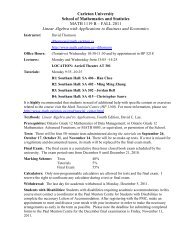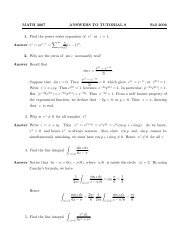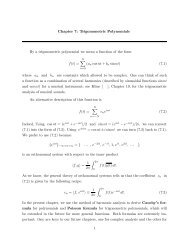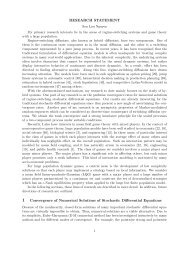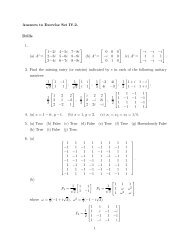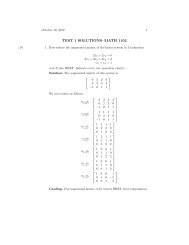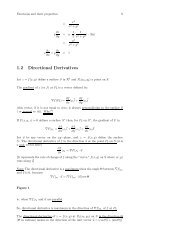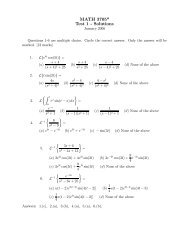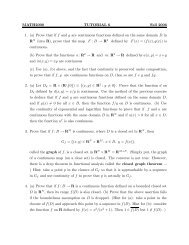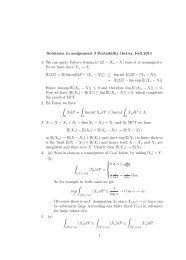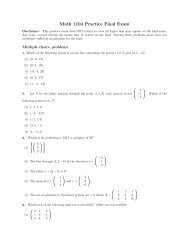CHAPTER II DIMENSION In the present chapter we investigate ...
CHAPTER II DIMENSION In the present chapter we investigate ...
CHAPTER II DIMENSION In the present chapter we investigate ...
Create successful ePaper yourself
Turn your PDF publications into a flip-book with our unique Google optimized e-Paper software.
(Don’t forget that <strong>the</strong> <strong>the</strong>orem <strong>we</strong> are proving now mainly concerns a linear transformation,<br />
namely T . Naturally <strong>we</strong> apply T to both sides of <strong>the</strong> identity and see what happens.) Apply<br />
T to (2.3.1) above and write down T (a1v1 + · · · + akvk + b1u1 + · · · + brur) = T 0. Because<br />
T is linear, <strong>we</strong> can rewrite this as<br />
a1T v1 + · · · + akT vk + b1T u1 + · · · + brT ur = 0.<br />
Recall what happens when <strong>we</strong> apply T to <strong>the</strong>se v’s and u’s: T vj = 0, T uk = wk. So<br />
b1w1 + b2w2 + · · · + brwr = 0. (2.3.2)<br />
But w1, w2, . . . , wr form a basis of T (V ). <strong>In</strong> particular, <strong>the</strong>y are linearly independent. So<br />
(2.3.2) entails b1 = b2 = · · · = br = 0. Now go back to (2.3.1). It becomes<br />
a1v1 + a2v2 + · · · + akvk = 0.<br />
Since v1, v2, . . . , vk are linearly independent, (because <strong>the</strong>y form a basis of ker T ), <strong>we</strong> have<br />
a1 = a2 = · · · = ak = 0. Hence B ≡ {v1, . . . , vk, u1, . . . , ur} are linearly independent.<br />
Next <strong>we</strong> prove that B spans V . To this end, take an arbitrary vector v in V . Our goal<br />
is to write v as a linear combination of vectors from B. Applying T to v, <strong>we</strong> get T v, a vector<br />
in <strong>the</strong> range T (V ). <strong>In</strong> T (V ) <strong>we</strong> have already picked a basis, namely {w1, w2, . . . , wr},<br />
which is waiting to be used. Thus T v as a linear combination of <strong>the</strong>m, say T (v) =<br />
β1w1 + β2w2 + · · · + βrwr. Recall that w1 = T u1, w2 = T u2 etc. So<br />
This tells us T z = 0, where<br />
T v = β1T u1 + · · · + βrT ur = T (β1u1 + · · · + βrur).<br />
z = v − (β1u1 + · · · + βrur). (2.3.3)<br />
<strong>In</strong> o<strong>the</strong>r words, z is in ker T . Now, in ker T <strong>the</strong>re is a basis of vectors waiting for us, namely<br />
v1, v2, . . . , vk. Hence z is a linear combination of <strong>the</strong>se basis vectors, say<br />
z = α1v1 + α2v2 + · · · + αkvk. (2.3.4)<br />
Combining (2.3.3) and (2.3.4), <strong>we</strong> end up with v = α1v1 + · · · + αkvk + β1u1 + · · · + βrur,<br />
which is exactly what <strong>we</strong> want.<br />
Theorem 2.3.2. If M and N are subspaces of a (finite dimensional) vector space V ,<br />
<strong>the</strong>n<br />
dim(M + N) + dim(M ∩ N) = dim M + dim N.<br />
18



